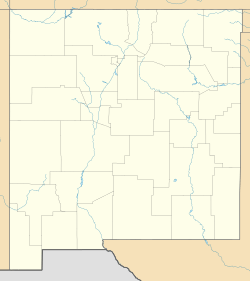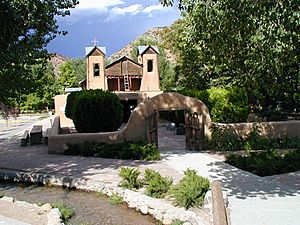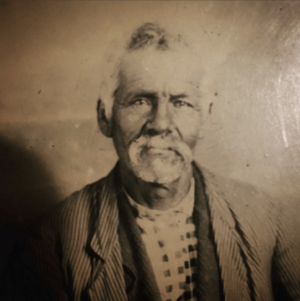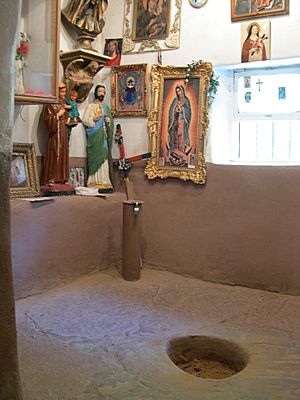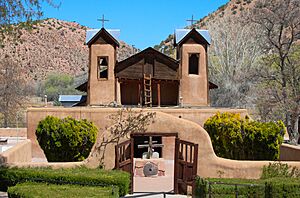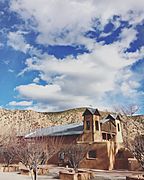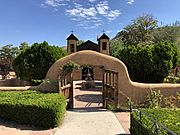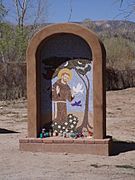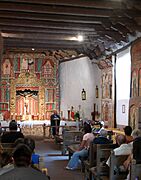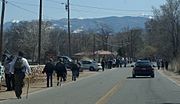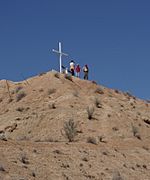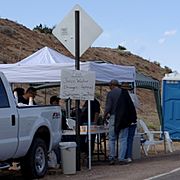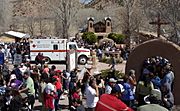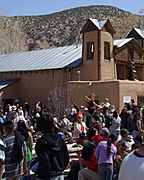El Santuario de Chimayo facts for kids
|
El Santuario de Chimayó
|
|
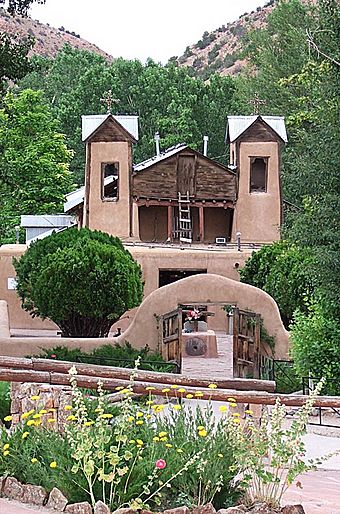 |
|
| Location | 1 mi. NW of Santa Cruz Reservoir Dam |
|---|---|
| Nearest city | Chimayo, New Mexico |
| Area | 6.4 acres (2.6 ha) |
| Built | 1816 |
| NRHP reference No. | 70000412 |
Quick facts for kids Significant dates |
|
| Added to NRHP | April 15, 1970 |
| Designated NHL | April 15, 1970 |
El Santuario de Chimayó is a special Roman Catholic church in Chimayo, New Mexico, United States. The word Santuario means "sanctuary" in Spanish. This church is a famous shrine and a National Historic Landmark. It is well-known for how it started and as a place where many people go on a pilgrimage today. Almost 300,000 people visit it every year. Some even call it the most important Catholic pilgrimage spot in the United States.
Contents
What the Santuario Looks Like
The Santuario is located on Juan Medina Drive in Chimayo. You enter it through a courtyard surrounded by walls. The church is built from adobe, which is a type of sun-dried brick. It has a bell tower on each side.
The church is about 60 feet (18 meters) long and 24 feet (7 meters) wide. Its walls are very thick, more than 3 feet (about 1 meter) wide! Pointed tops were added to the towers after 1917. A metal roof was also added around the 1920s.
The beautiful doors were carved by a carpenter named Pedro Domínguez in the 1800s. An interesting part of the church is two rooms side-by-side at the entrance. These rooms form a hallway, or narthex, and were once used for storage.
Inside the main part of the church, called the nave, there is a large crucifix. It shows Christ of Esquipulas and is 6 feet (1.8 meters) tall. You can also see other cool folk-art decorations. These include five reredoses, which are decorated screens behind the altar. There is also a small statue of St. James the Great.
The Little Well and Holy Dirt
A small room inside the church is called el pocito, which means "the little well." This room has a round pit in the floor. This pit is the source of "holy dirt," or tierra bendita. Many people believe this dirt has special healing powers.
Next to this room is a prayer room. Here, you can see many ex-votos. These are small objects left by people to show thanks for a miracle. The room also displays photos, old crutches, and other items. These are all left by people who say they were healed after visiting the Santuario.
The Santuario's Story
In the early 1800s, about 19 families lived in the area. It was then called El Potrero de Chimayó, meaning "the pasture of Chimayó." The land where the Santuario stands belonged to Don Bernardo Abeyta. He was one of the first members of a religious group called the Penitentes in that area.
Don Bernardo was likely very devoted to the Christ of Esquipulas. This is a famous pilgrimage site in Guatemala where people believe the clay has healing powers. In fact, one of Don Bernardo's nephews was named Juan de Esquipulas in 1805.
Building the Church
Around 1810, Bernardo Abeyta built a small chapel on his land. It was dedicated to the Christ of Esquipulas. On November 15, 1813, he asked Father Sebastián Álvarez for permission to build a bigger church. He wanted the people of El Potrero to be able to worship Jesus as he appeared at Esquipulas and attend Mass.
Father Álvarez wrote a letter the next day. He mentioned that people were reporting cures and many pilgrims were coming to the site. On February 8, 1814, permission was granted. By 1816, the small chapel was replaced by the larger El Santuario shrine that we see today.
Ownership Changes
Don Bernardo's daughter, Carmen Abeyta de Chaves, inherited the property. She kept it even when others tried to make her give it to the Church. She earned money from donations given by pilgrims. Later, her daughter, María de los Ángeles Chaves, inherited the church.
In 1929, the owners were having money problems. Members of a group called the Spanish Colonial Arts Society bought the property. They then gave it to the Archdiocese of Santa Fe, which is part of the Catholic Church.
El Santuario de Chimayó was recognized as a National Historic Landmark in 1970. This means it's a very important historical place in the United States.
Annual Celebrations
Every year, about 300,000 people from all over the world visit the Santuario de Chimayó. Many come during Holy Week, especially on Holy Thursday and Good Friday. Some seek blessings, while others come to fulfill a promise they made.
Walking to the Santuario is a tradition. Some pilgrims walk from as far away as Albuquerque, which is about 90 miles (150 km) away. This pilgrimage started in the 1800s. It became even more popular after World War II, especially among survivors of the Bataan Death March.
The Holy Dirt Tradition
Many visitors take a small amount of the "holy dirt" from el pocito. They often hope for a miraculous cure for themselves or for someone who couldn't make the trip. In the past, some people even ate the dirt. Today, people usually rub themselves with the dirt or simply keep it.
The Church replaces the dirt in the pocito from nearby hillsides. They do this sometimes more than once a day. They replace about 25 to 30 tons of dirt each year! The Church does not say whether miracles have happened at the Santuario.
Feast Days
The feast of Our Lord of Esquipulas is celebrated on January 15, or on the Sunday closest to that date. The feast of St. James the Great (Santiago) is celebrated on the fourth weekend of July.
Legends and Stories
There are several interesting legends about how the Santuario came to be.
One story says that before the Spanish arrived, there was a hot spring near the site. The Tewa Native Americans believed this spring had healing powers.
Another legend tells that during Holy Week, Don Bernardo Abeyta (or a friar) saw a bright light on the hillside. He dug there with his bare hands and found a crucifix. He gave it to Father Álvarez, who took it to the Santa Cruz church. But the crucifix mysteriously returned to the spot where Abeyta found it. This happened three times! So, Father Álvarez and Abeyta decided to build a chapel right on that spot to keep the crucifix.
Yet another version says that Abeyta was watching his sheep. He was feeling grateful, even though he was sick. Then, he saw a vision of his patron saint, San Esquipula. The saint called to him. Abeyta went to the spot where the saint appeared and knelt down. He was immediately cured! Other people were also cured there, and Abeyta built the chapel to show his thanks.
A different story suggests that the crucifix belonged to a priest from Esquipulas. This priest came with the first Spanish settlers in Chimayo. He was killed by Native Americans and buried in Chimayo. In the spring of 1810, a flood from the Santa Cruz River uncovered his body and the crucifix. People who remembered the priest then dedicated the shrine to the Christ of Esquipulas.
Gallery
-
Shrine to St. Francis of Assisi
Pilgrimage on Good Friday
See also
 In Spanish: Santuario de Chimayó para niños
In Spanish: Santuario de Chimayó para niños
- Top eight Catholic pilgrimage destinations in the US
- Cristos Negros of Central America and Mexico
- National Register of Historic Places listings in Santa Fe County, New Mexico
- List of National Historic Landmarks in New Mexico


